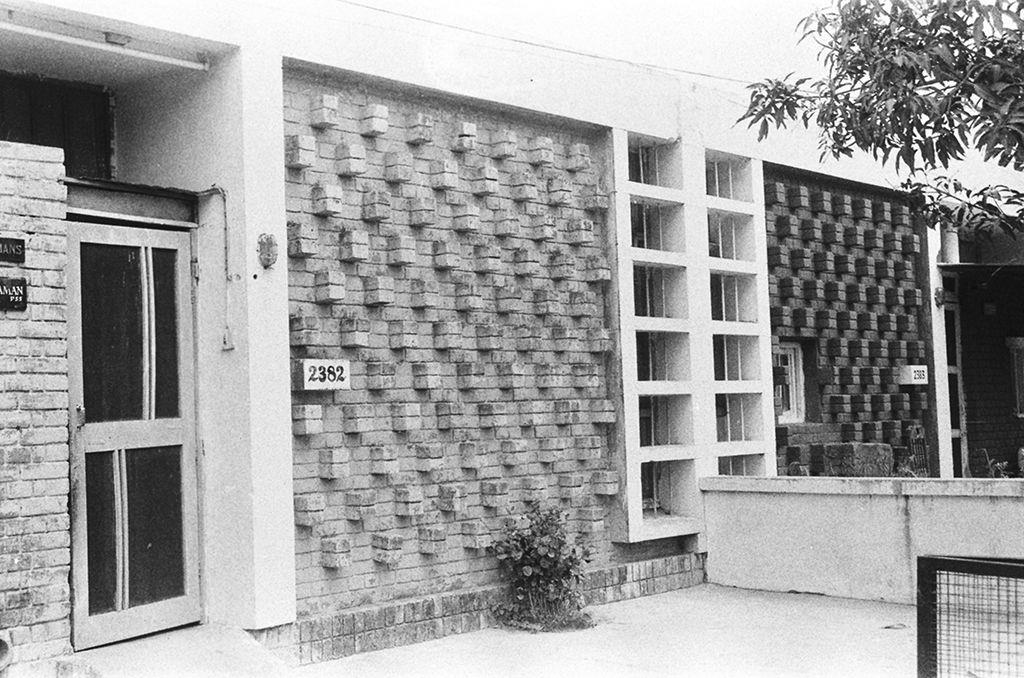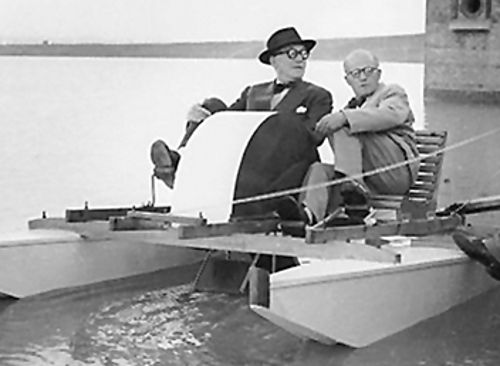
Low-cost houses with brick jaalis represent the signature design of Pierre Jeanneret.
Rajnish Wattas & Deepika Gandhi
LE CORBUSIER described architecture as frozen music. Extending the musical metaphor — if his own work was Beethoven’s Fifth Symphony, all thunder and glory, then Pierre Jeanneret’s work was like Chopin’s Nocturnes, low-key musical trills of a piano. But the two genres collectively embody the quintessential Modernism of 20th century’s architectural symphony.
Their individual personalities, too, reflected contrasts. Le Corbusier, tall, imposing and gaunt, was always seen with a formal bow tie and his hallmark thick, round black glasses; while Jeanneret, a gentle father figure to the young Indian team, was mostly attired in casual baggy bush shirts.

However, in Chandigarh’s creation, the two worked in unison. While Le Corbusier evolved the city’s layout plan and designed its piece de resistance, the Capitol Complex, the bulk of everyday civic and public functions was left to Jeanneret to flesh out.
Corbusier’s ensemble of sculptural, powerful compositions in raw concrete edifices of the Assembly, Secretariat and High Court, interspersed with enigmatic ‘monuments’, is just 2 km away from the low-cost housing designed by Jeanneret in Sector 22. The visual axis of Jan Marg ‘Boulevard Ceremonial’ connecting the two, defines the architectural spectrum of Chandigarh, created by the two masters.
In fact, when the duo of PN Thapar and PL Varma of the Punjab Government toured Europe during the early 1950s in search of a suitable architect for the ambitious and somewhat audacious Chandigarh Project, they were unable to convince Corbusier to agree. He would not agree unless they took on Jeanneret, his trusted and competent cousin, as his team member.

While Corbusier was taken in as the overall plenipotentiary architectural adviser, Jeanneret was the in-residence senior architect to head the team of Maxwell Fry, Jane Drew and the Indian associates. He was permanently stationed in Chandigarh, while Corbusier was mandated to spend two months in a year in summer and winter spells. The large volume of the new capital city’s residences and public works like schools, colleges, and institutional buildings were done by Pierre Jeanneret and the team.
Arnold-André-Pierre Jeanneret-Gris was born on March 22, 1896, at Geneva, not far from his older cousin Le Corbusier’s birthplace in the Jura mountains of Switzerland. As a young student, Pierre was a brilliant painter, artist and architect, greatly influenced by his cousin Charles-Édouard Jeanneret (Le Corbusier). From 1922 until 1940, Corbusier and Jeanneret worked together in partnership in their studio in Paris. But World War II took them away on their own individual paths, only to come together again at Chandigarh.
As a prolific designer, Jeanneret evolved a unique architectural vocabulary — now called the Chandigarh style — for government housing and some private residences. However, it was not an easy task considering the limitations of budget, floor space, technology and skilled manpower.
The predominant use of exposed brick, small windows and absence of features of a typical Indian house like verandahs and central courtyards were not due to his lack of understanding of the local conditions, but were a financial necessity. Despite these constraints, Jeanneret created all kinds of houses — from the Chief Minister’s to the smallest house of a peon — that would offer a dignified and aesthetic dwelling. The unique aesthetics of Jeanneret’s residential architecture is based on a play of exposed brickwork, plastered surfaces and sometimes stone panels. Brick jaalis served as ornamental and functional elements that afforded privacy to terraces and verandahs while allowing ventilation.
His creative repertoire was not only limited to these dwellings. Panjab University is his tour de force. He designed landmark buildings like Gandhi Bhawan, Fine Arts Museum, University Library and the Student Centre. The diverse buildings are tied together by the use of red sandstone. The highly sculptural yet elegant Gandhi Bhawan symbolises the purity and simplicity of a lotus placed in an organic-shaped reflecting pool.
In the architects’ office for the project that had moved from Simla to the capital’s site (conserved as Le Corbusier Centre), Jeanneret skilfully combined features of low-cost architecture and climate-responsive design to create a comfortable work environment. He whole-heartedly embraced India, its culture and its people. He made extensive trips to surrounding villages to understand the local context, climate, materials and most importantly, the people.
Along with the celebration of the humble earthy brick, this ‘god of small things’ gave us numerous decorative details, paddle boats, manhole covers and murals — besides his hallmark Chandigarh furniture! The astoundingly huge prices that the heritage furniture currently commands in the international markets is perhaps a belated realisation of the genius embedded in these simple but elegant wood and cane artefacts, created by the thousands then for everyday use.
Jeanneret had a deep attachment with Chandigarh. When he died on December 4, 1967, it was his wish that his ashes be immersed in the Sukhna.
The city, too, hasn’t forgotten his legacy, as the Chandigarh Administration has dedicated a museum to his contributions, on display at house number 57 of Sector 5. He had designed the house himself and lived there for almost 11 years. It displays details of his work such as the fireplace finished in exposed brick, elaborately designed ledges and niches, unique light fixtures, innovative handrail of the sculptural spiral staircase. Inaugurated on March 22, 2017, it showcases Jeanneret’s works though sepia-tinted photographs, besides rare personal pictures and communications. It also displays a replica of the iconic paddle boat designed by Jeanneret used in the early days of Sukhna’s boat club.
— Wattas is former principal of Chandigarh College of Architecture & Gandhi is Director, Le Corbusier Centre, Chandigarh
Join Whatsapp Channel of The Tribune for latest updates.




























